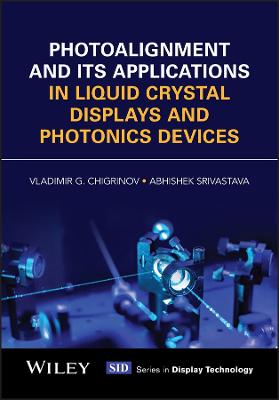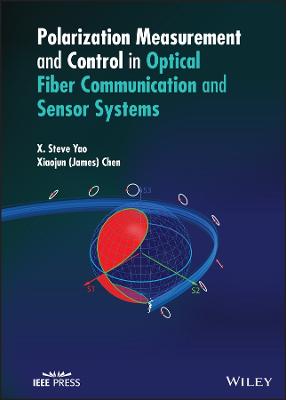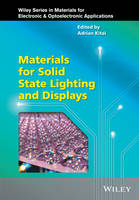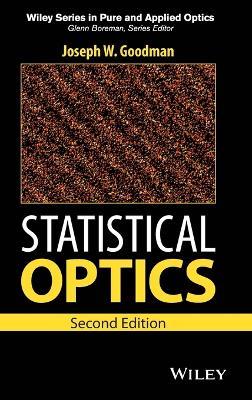Principles of Physical Optics
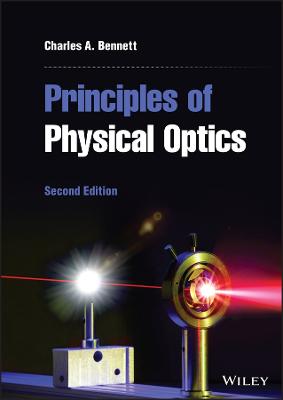 -15%
portes grátis
-15%
portes grátis
Principles of Physical Optics
Bennett, Charles A.
John Wiley & Sons Inc
08/2022
592
Dura
Inglês
9781119801795
15 a 20 dias
1350
Descrição não disponível.
Preface xiii
Acknowledgments xv
1 The Physics of Waves 1
1.1 Introduction 1
1.2 One-Dimensional Wave Equation 1
1.3 General Solutions to the 1D Wave Equation 3
1.4 Harmonic Traveling Waves 5
1.5 The Principle of Superposition 7
1.5.1 Periodic Traveling Waves 7
1.5.2 Linear Independence 7
1.6 Complex Numbers and the Complex Representation 8
1.6.1 Complex Algebra 9
1.6.2 The Complex Representation of Harmonic Waves 11
1.7 The Three-Dimensional Wave Equation 12
1.7.1 Spherical Coordinates 13
1.7.2 Three-Dimensional Plane Waves 13
1.7.3 Spherical Waves 15
Problems 16
2 Electromagnetic Waves and Photons 23
2.1 Introduction 23
2.2 Electromagnetism 23
2.3 Electromagnetic Wave Equations 29
2.3.1 Transverse Electromagnetic Waves 31
2.3.2 Energy Flow and the Poynting Vector 33
2.3.3 Irradiance 34
2.4 Photons 37
2.4.1 Single-Photon Interference 41
2.5 The Electromagnetic Spectrum 42
Problems 43
3 Reflection and Refraction 51
3.1 Introduction 51
3.2 Overview of Reflection and Refraction 51
3.2.1 Fermat's Principle of Least Time 55
3.3 Maxwell's Equations at an Interface 57
3.3.1 Boundary Conditions 57
3.3.2 Electromagnetic Waves at an Interface 58
3.4 The Fresnel Equations 60
3.4.1 Incident Wave Polarized Normal to the Plane of Incidence 61
3.4.2 Incident Wave Polarized Parallel to the Plane of Incidence 63
3.5 Interpretation of the Fresnel Equations 65
3.5.1 Normal Incidence 66
3.5.2 Brewster's Angle 66
3.5.3 Total Internal Reflection 68
3.5.4 Plots of the Fresnel Equations vs. Incident Angle 71
3.5.5 Phase Changes on Reflection 72
3.5.5.1 Summary 75
3.6 Reflectivity and Transmissivity 75
3.6.1 Plots of Reflectivity and Transmissivity vs. Incident Angle 78
3.6.2 The Evanescent Wave 79
3.7 Scattering 81
3.7.1 Atmospheric Scattering 82
3.7.2 Rainbows 82
3.7.3 Parhelia 85
3.8 Optical Materials 86
3.9 Dispersion 86
3.9.1 Dispersion in Dielectric Media 86
3.9.1.1 Nonconducting Gases 92
3.9.2 Dispersion in Conducting Media 94
3.9.2.1 Reflection from Conductors 97
Problems 100
4 Geometric Optics I 107
4.1 Introduction 107
4.2 Reflection and Refraction at Aspheric Surfaces 107
4.3 Reflection and Refraction at a Spherical Surface 112
4.3.1 The Paraxial Approximation 112
4.3.2 Spherical Reflecting Surfaces 113
4.3.2.1 Sign Conventions for Reflecting Surfaces 114
4.3.3 Spherical Refracting Surfaces 115
4.3.4 Sign Conventions and Ray Diagrams 117
4.4 Lens Combinations 121
4.4.1 Thin Lenses in Close Combination 122
4.5 Optical Instruments 123
4.5.1 The Camera 123
4.5.2 The Eye 124
4.5.3 The Magnifying Glass 125
4.5.4 The Compound Microscope 126
4.5.5 The Telescope 127
4.5.6 The Exit Pupil 128
4.6 Optical Fibers 129
Problems 133
5 Geometric Optics II 139
5.1 Introduction 139
5.2 Aberrations 139
5.2.1 Chromatic Aberration 139
5.2.2 Spherical Aberration 143
5.2.3 Astigmatism and Coma 143
5.2.4 Field Curvature 143
5.2.5 Diffraction 144
5.3 Principal Points and Effective Focal Lengths in Paraxial Optics 144
5.4 Thick Paraxial Lenses 148
5.4.1 Principal Points and Effective Focal Lengths of Thick Paraxial Lenses 149
5.5 Introduction to Matrix Methods in Paraxial Geometrical Optics 153
5.5.1 The Translation Matrix 153
5.5.2 The Refraction Matrix 155
5.5.3 The Reflection Matrix 156
5.5.4 The Ray Transfer Matrix 157
5.5.5 Location of Principal Points and Effective Focal Lengths for an Optical System 161
5.6 Radiometry 165
5.6.1 Extended Sources 166
5.6.1.1 Spectral Distributions 168
5.6.1.2 Conservation of Radiance 168
5.6.2 Radiometry of Blackbody Sources 169
5.6.3 Rayleigh-Jeans Theory and the Ultraviolet Catastrophe 170
5.6.4 Planck's Quantum Theory of Blackbody Radiation 173
Problems 176
6 Polarization 185
6.1 Introduction 185
6.2 Linear Polarization 185
6.2.1 Linear Polarizers 186
6.2.2 Linear Polarizer Design 188
6.3 Birefringence 191
6.4 Circular and Elliptical Polarization 194
6.4.1 Wave Plates and Circular Polarizers 196
6.5 Jones Vectors and Matrices 199
6.5.1 Jones Matrices 201
6.5.2 Birefringent Colors 204
Problems 207
7 Superposition and Interference 213
7.1 Introduction 213
7.2 Superposition of Harmonic Waves 213
7.3 Interference Between Two Monochromatic Electromagnetic Waves 214
7.3.1 Linear Power Detection 215
7.3.2 Interference Between Beams with the Same Frequency 216
7.3.2.1 Young's Double-Slit Experiment 216
7.3.3 Thin-Film Interference 219
7.3.4 Quasi-Monochromatic Sources 222
7.3.5 Fringe Geometry 222
7.3.5.1 Lloyd's Mirror 223
7.3.5.2 Newton's Rings 223
7.3.6 Interference Between Beams with Different Frequencies 224
7.3.6.1 Coherent Detection 226
7.4 Fourier Analysis 229
7.4.1 Fourier Transforms 229
7.4.2 Position Space, k-Space Domain 230
7.4.3 Frequency-Time Domain 234
7.5 Properties of Fourier Transforms 234
7.5.1 Symmetry Properties 234
7.5.2 Linearity 235
7.5.3 Transform of a Transform 236
7.6 Wavepackets 236
7.7 Group and Phase Velocity 241
7.8 Interferometry 243
7.8.1 Energy Conservation and Complementary Fringe Patterns 248
7.9 Single-Photon Interference 250
7.10 Multiple-Beam Interference 251
7.10.1 The Scanning Fabry-Perot Interferometer 254
7.11 Interference in Multilayer Films 257
7.11.1 Antireflection Films 261
7.11.2 High-Reflectance Films 263
7.11.2.1 Fabry-Perot Interference Filters 264
7.12 Coherence 265
7.12.1 Temporal Coherence 265
7.12.2 Spatial Coherence 266
7.12.3 Michelson's Stellar Interferometer 269
7.12.4 Irradiance Interferometry 270
7.12.5 Telescope Arrays 271
Problems 272
8 Diffraction 281
8.1 Introduction 281
8.2 Huygens' Principle 282
8.2.1 Babinet's Principle 284
8.3 Fraunhofer Diffraction 284
8.3.1 Single Slit 285
8.3.2 Rectangular Aperture 290
8.3.3 Circular Aperture 291
8.3.4 Optical Resolution 294
8.3.5 More on Stellar Interferometry 295
8.3.6 Double Slit 295
8.3.7 N Slits: The Diffraction Grating 296
8.3.8 The Diffraction Grating 298
8.3.8.1 Chromatic Resolving Power 302
8.3.9 Fraunhofer Diffraction as a Fourier Transform 304
8.3.10 Apodization 306
8.3.10.1 Apertures with Circular Symmetry 307
8.4 Fresnel Diffraction 309
8.4.1 Fresnel Zones 310
8.4.1.1 Circular Apertures 313
8.4.1.2 Circular Obstacles 313
8.4.1.3 Fresnel Zone Plate 316
8.4.2 Holography 320
8.4.3 Numerical Analysis of Fresnel Diffraction with Circular Symmetry 321
8.4.4 Fresnel Diffraction from Apertures with Cartesian Symmetry 323
8.4.4.1 Semi-Infinite Straightedge 326
8.4.4.2 Single Slit 327
8.4.4.3 Rectangular Aperture 329
8.5 Introduction to Quantum Electrodynamics 330
8.5.1 Feynman's Interpretation 333
Problems 334
9 Lasers 343
9.1 Introduction 343
9.2 Energy Levels in Atoms, Molecules, and Solids 343
9.2.1 Atomic Energy Levels 343
9.2.2 Molecular Energy Levels 346
9.2.3 Solid-State Energy Bands 348
9.2.4 Semiconductor Devices 352
9.3 Stimulated Emission and Light Amplification 354
9.4 Laser Systems 357
9.4.1 Atomic Gas Lasers 358
9.4.1.1 Helium-Neon Laser 359
9.4.2 Molecular Gas Lasers 360
9.4.2.1 Carbon Dioxide Laser 360
9.4.3 Solid-State Lasers 362
9.4.3.1 Diode Lasers 363
9.4.4 Other Laser Systems 364
9.5 Longitudinal Cavity Modes 365
9.6 Frequency Stability 366
9.7 Introduction to Gaussian Beams 367
9.7.1 Overview of Gaussian Beam Properties 367
9.8 Gaussian Beam Properties 369
9.8.1 Approximate Solutions to the Wave Equation 370
9.8.2 Paraxial Spherical Gaussian Beams 372
9.8.3 Gaussian Beam Focusing 373
9.8.4 Matrix Methods and the ABCD Law 376
9.9 Laser Cavities 377
9.9.1 Laser Cavity with Equal Mirror Curvatures 377
9.9.2 Laser Cavity with Unequal Mirror Curvatures 379
9.9.3 Stable Resonators 381
9.9.4 Traveling Wave Resonators 385
9.9.5 Unstable Resonators 385
9.9.6 Transverse Cavity Modes 386
9.10 Electro-optics and Nonlinear Optics 387
9.10.1 The Electro-optic Effect 388
9.10.1.1 Pockels Cells 388
9.10.1.2 Kerr Cells 390
9.10.2 Optical Activity 390
9.10.2.1 Faraday Rotation 392
9.10.3 Acousto-optic Effect 393
9.10.4 Nonlinear Optics 397
9.10.4.1 Harmonic Generation 398
9.10.4.2 Phase Conjugation Reflection by Degenerate Four-Wave Mixing 402
9.10.5 Frequency Mixing 404
Problems 405
10 Optical Imaging 419
10.1 Introduction 419
10.2 Abbe Theory of Image Formation 419
10.2.1 Phase Contrast Microscope 424
10.3 The Point Spread Function 425
10.3.1 Coherent vs. Incoherent Images 426
10.3.2 Speckle 430
10.4 Resolving Power of Optical Instruments 431
10.5 Image Recording 432
10.5.1 Photographic Film 433
10.5.2 Digital Detector Arrays 434
10.6 Contrast Transfer Function 436
10.7 Spatial Filtering 437
10.8 Adaptive Optics 441
Problems 443
Appendix A Chapter 1 Appendix: Transverse Traveling Waves on a String 449
Appendix B Chapter 2 Appendix: Electromagnetic Wave Equations 451
B. 1 Maxwell's Equations in Differential Form and Wave Equations for ?E and ?B 451
B. 2 Method 1: Cartesian Coordinates 451
B.2. 1 Wave Equations for ?E and ?B 455
B. 3 Method 2: Vector Calculus 456
B.3. 1 Wave Equations for ?E and ?B 457
Appendix C Chapter 5 Appendix: Calculation of the Jeans Number 459
Appendix D Chapter 7 Appendix: Fourier Series 461
D.1 Real Fourier Series 461
D.2 Complex Fourier Series 467
D.3 Nonperiodic Functions and Fourier Transforms 468
Problems 470
Appendix E Solutions to Selected Problems 473
Bibliography 553
Index 555
Acknowledgments xv
1 The Physics of Waves 1
1.1 Introduction 1
1.2 One-Dimensional Wave Equation 1
1.3 General Solutions to the 1D Wave Equation 3
1.4 Harmonic Traveling Waves 5
1.5 The Principle of Superposition 7
1.5.1 Periodic Traveling Waves 7
1.5.2 Linear Independence 7
1.6 Complex Numbers and the Complex Representation 8
1.6.1 Complex Algebra 9
1.6.2 The Complex Representation of Harmonic Waves 11
1.7 The Three-Dimensional Wave Equation 12
1.7.1 Spherical Coordinates 13
1.7.2 Three-Dimensional Plane Waves 13
1.7.3 Spherical Waves 15
Problems 16
2 Electromagnetic Waves and Photons 23
2.1 Introduction 23
2.2 Electromagnetism 23
2.3 Electromagnetic Wave Equations 29
2.3.1 Transverse Electromagnetic Waves 31
2.3.2 Energy Flow and the Poynting Vector 33
2.3.3 Irradiance 34
2.4 Photons 37
2.4.1 Single-Photon Interference 41
2.5 The Electromagnetic Spectrum 42
Problems 43
3 Reflection and Refraction 51
3.1 Introduction 51
3.2 Overview of Reflection and Refraction 51
3.2.1 Fermat's Principle of Least Time 55
3.3 Maxwell's Equations at an Interface 57
3.3.1 Boundary Conditions 57
3.3.2 Electromagnetic Waves at an Interface 58
3.4 The Fresnel Equations 60
3.4.1 Incident Wave Polarized Normal to the Plane of Incidence 61
3.4.2 Incident Wave Polarized Parallel to the Plane of Incidence 63
3.5 Interpretation of the Fresnel Equations 65
3.5.1 Normal Incidence 66
3.5.2 Brewster's Angle 66
3.5.3 Total Internal Reflection 68
3.5.4 Plots of the Fresnel Equations vs. Incident Angle 71
3.5.5 Phase Changes on Reflection 72
3.5.5.1 Summary 75
3.6 Reflectivity and Transmissivity 75
3.6.1 Plots of Reflectivity and Transmissivity vs. Incident Angle 78
3.6.2 The Evanescent Wave 79
3.7 Scattering 81
3.7.1 Atmospheric Scattering 82
3.7.2 Rainbows 82
3.7.3 Parhelia 85
3.8 Optical Materials 86
3.9 Dispersion 86
3.9.1 Dispersion in Dielectric Media 86
3.9.1.1 Nonconducting Gases 92
3.9.2 Dispersion in Conducting Media 94
3.9.2.1 Reflection from Conductors 97
Problems 100
4 Geometric Optics I 107
4.1 Introduction 107
4.2 Reflection and Refraction at Aspheric Surfaces 107
4.3 Reflection and Refraction at a Spherical Surface 112
4.3.1 The Paraxial Approximation 112
4.3.2 Spherical Reflecting Surfaces 113
4.3.2.1 Sign Conventions for Reflecting Surfaces 114
4.3.3 Spherical Refracting Surfaces 115
4.3.4 Sign Conventions and Ray Diagrams 117
4.4 Lens Combinations 121
4.4.1 Thin Lenses in Close Combination 122
4.5 Optical Instruments 123
4.5.1 The Camera 123
4.5.2 The Eye 124
4.5.3 The Magnifying Glass 125
4.5.4 The Compound Microscope 126
4.5.5 The Telescope 127
4.5.6 The Exit Pupil 128
4.6 Optical Fibers 129
Problems 133
5 Geometric Optics II 139
5.1 Introduction 139
5.2 Aberrations 139
5.2.1 Chromatic Aberration 139
5.2.2 Spherical Aberration 143
5.2.3 Astigmatism and Coma 143
5.2.4 Field Curvature 143
5.2.5 Diffraction 144
5.3 Principal Points and Effective Focal Lengths in Paraxial Optics 144
5.4 Thick Paraxial Lenses 148
5.4.1 Principal Points and Effective Focal Lengths of Thick Paraxial Lenses 149
5.5 Introduction to Matrix Methods in Paraxial Geometrical Optics 153
5.5.1 The Translation Matrix 153
5.5.2 The Refraction Matrix 155
5.5.3 The Reflection Matrix 156
5.5.4 The Ray Transfer Matrix 157
5.5.5 Location of Principal Points and Effective Focal Lengths for an Optical System 161
5.6 Radiometry 165
5.6.1 Extended Sources 166
5.6.1.1 Spectral Distributions 168
5.6.1.2 Conservation of Radiance 168
5.6.2 Radiometry of Blackbody Sources 169
5.6.3 Rayleigh-Jeans Theory and the Ultraviolet Catastrophe 170
5.6.4 Planck's Quantum Theory of Blackbody Radiation 173
Problems 176
6 Polarization 185
6.1 Introduction 185
6.2 Linear Polarization 185
6.2.1 Linear Polarizers 186
6.2.2 Linear Polarizer Design 188
6.3 Birefringence 191
6.4 Circular and Elliptical Polarization 194
6.4.1 Wave Plates and Circular Polarizers 196
6.5 Jones Vectors and Matrices 199
6.5.1 Jones Matrices 201
6.5.2 Birefringent Colors 204
Problems 207
7 Superposition and Interference 213
7.1 Introduction 213
7.2 Superposition of Harmonic Waves 213
7.3 Interference Between Two Monochromatic Electromagnetic Waves 214
7.3.1 Linear Power Detection 215
7.3.2 Interference Between Beams with the Same Frequency 216
7.3.2.1 Young's Double-Slit Experiment 216
7.3.3 Thin-Film Interference 219
7.3.4 Quasi-Monochromatic Sources 222
7.3.5 Fringe Geometry 222
7.3.5.1 Lloyd's Mirror 223
7.3.5.2 Newton's Rings 223
7.3.6 Interference Between Beams with Different Frequencies 224
7.3.6.1 Coherent Detection 226
7.4 Fourier Analysis 229
7.4.1 Fourier Transforms 229
7.4.2 Position Space, k-Space Domain 230
7.4.3 Frequency-Time Domain 234
7.5 Properties of Fourier Transforms 234
7.5.1 Symmetry Properties 234
7.5.2 Linearity 235
7.5.3 Transform of a Transform 236
7.6 Wavepackets 236
7.7 Group and Phase Velocity 241
7.8 Interferometry 243
7.8.1 Energy Conservation and Complementary Fringe Patterns 248
7.9 Single-Photon Interference 250
7.10 Multiple-Beam Interference 251
7.10.1 The Scanning Fabry-Perot Interferometer 254
7.11 Interference in Multilayer Films 257
7.11.1 Antireflection Films 261
7.11.2 High-Reflectance Films 263
7.11.2.1 Fabry-Perot Interference Filters 264
7.12 Coherence 265
7.12.1 Temporal Coherence 265
7.12.2 Spatial Coherence 266
7.12.3 Michelson's Stellar Interferometer 269
7.12.4 Irradiance Interferometry 270
7.12.5 Telescope Arrays 271
Problems 272
8 Diffraction 281
8.1 Introduction 281
8.2 Huygens' Principle 282
8.2.1 Babinet's Principle 284
8.3 Fraunhofer Diffraction 284
8.3.1 Single Slit 285
8.3.2 Rectangular Aperture 290
8.3.3 Circular Aperture 291
8.3.4 Optical Resolution 294
8.3.5 More on Stellar Interferometry 295
8.3.6 Double Slit 295
8.3.7 N Slits: The Diffraction Grating 296
8.3.8 The Diffraction Grating 298
8.3.8.1 Chromatic Resolving Power 302
8.3.9 Fraunhofer Diffraction as a Fourier Transform 304
8.3.10 Apodization 306
8.3.10.1 Apertures with Circular Symmetry 307
8.4 Fresnel Diffraction 309
8.4.1 Fresnel Zones 310
8.4.1.1 Circular Apertures 313
8.4.1.2 Circular Obstacles 313
8.4.1.3 Fresnel Zone Plate 316
8.4.2 Holography 320
8.4.3 Numerical Analysis of Fresnel Diffraction with Circular Symmetry 321
8.4.4 Fresnel Diffraction from Apertures with Cartesian Symmetry 323
8.4.4.1 Semi-Infinite Straightedge 326
8.4.4.2 Single Slit 327
8.4.4.3 Rectangular Aperture 329
8.5 Introduction to Quantum Electrodynamics 330
8.5.1 Feynman's Interpretation 333
Problems 334
9 Lasers 343
9.1 Introduction 343
9.2 Energy Levels in Atoms, Molecules, and Solids 343
9.2.1 Atomic Energy Levels 343
9.2.2 Molecular Energy Levels 346
9.2.3 Solid-State Energy Bands 348
9.2.4 Semiconductor Devices 352
9.3 Stimulated Emission and Light Amplification 354
9.4 Laser Systems 357
9.4.1 Atomic Gas Lasers 358
9.4.1.1 Helium-Neon Laser 359
9.4.2 Molecular Gas Lasers 360
9.4.2.1 Carbon Dioxide Laser 360
9.4.3 Solid-State Lasers 362
9.4.3.1 Diode Lasers 363
9.4.4 Other Laser Systems 364
9.5 Longitudinal Cavity Modes 365
9.6 Frequency Stability 366
9.7 Introduction to Gaussian Beams 367
9.7.1 Overview of Gaussian Beam Properties 367
9.8 Gaussian Beam Properties 369
9.8.1 Approximate Solutions to the Wave Equation 370
9.8.2 Paraxial Spherical Gaussian Beams 372
9.8.3 Gaussian Beam Focusing 373
9.8.4 Matrix Methods and the ABCD Law 376
9.9 Laser Cavities 377
9.9.1 Laser Cavity with Equal Mirror Curvatures 377
9.9.2 Laser Cavity with Unequal Mirror Curvatures 379
9.9.3 Stable Resonators 381
9.9.4 Traveling Wave Resonators 385
9.9.5 Unstable Resonators 385
9.9.6 Transverse Cavity Modes 386
9.10 Electro-optics and Nonlinear Optics 387
9.10.1 The Electro-optic Effect 388
9.10.1.1 Pockels Cells 388
9.10.1.2 Kerr Cells 390
9.10.2 Optical Activity 390
9.10.2.1 Faraday Rotation 392
9.10.3 Acousto-optic Effect 393
9.10.4 Nonlinear Optics 397
9.10.4.1 Harmonic Generation 398
9.10.4.2 Phase Conjugation Reflection by Degenerate Four-Wave Mixing 402
9.10.5 Frequency Mixing 404
Problems 405
10 Optical Imaging 419
10.1 Introduction 419
10.2 Abbe Theory of Image Formation 419
10.2.1 Phase Contrast Microscope 424
10.3 The Point Spread Function 425
10.3.1 Coherent vs. Incoherent Images 426
10.3.2 Speckle 430
10.4 Resolving Power of Optical Instruments 431
10.5 Image Recording 432
10.5.1 Photographic Film 433
10.5.2 Digital Detector Arrays 434
10.6 Contrast Transfer Function 436
10.7 Spatial Filtering 437
10.8 Adaptive Optics 441
Problems 443
Appendix A Chapter 1 Appendix: Transverse Traveling Waves on a String 449
Appendix B Chapter 2 Appendix: Electromagnetic Wave Equations 451
B. 1 Maxwell's Equations in Differential Form and Wave Equations for ?E and ?B 451
B. 2 Method 1: Cartesian Coordinates 451
B.2. 1 Wave Equations for ?E and ?B 455
B. 3 Method 2: Vector Calculus 456
B.3. 1 Wave Equations for ?E and ?B 457
Appendix C Chapter 5 Appendix: Calculation of the Jeans Number 459
Appendix D Chapter 7 Appendix: Fourier Series 461
D.1 Real Fourier Series 461
D.2 Complex Fourier Series 467
D.3 Nonperiodic Functions and Fourier Transforms 468
Problems 470
Appendix E Solutions to Selected Problems 473
Bibliography 553
Index 555
Este título pertence ao(s) assunto(s) indicados(s). Para ver outros títulos clique no assunto desejado.
Physical optics textbook; optics textbook; introductory optics; optics basics; optics fundamentals; optics foundations; geometric optics; fourier analysis; lasers; nonlinear optics; optical imaging; gaussian beams; diffraction; interference
Preface xiii
Acknowledgments xv
1 The Physics of Waves 1
1.1 Introduction 1
1.2 One-Dimensional Wave Equation 1
1.3 General Solutions to the 1D Wave Equation 3
1.4 Harmonic Traveling Waves 5
1.5 The Principle of Superposition 7
1.5.1 Periodic Traveling Waves 7
1.5.2 Linear Independence 7
1.6 Complex Numbers and the Complex Representation 8
1.6.1 Complex Algebra 9
1.6.2 The Complex Representation of Harmonic Waves 11
1.7 The Three-Dimensional Wave Equation 12
1.7.1 Spherical Coordinates 13
1.7.2 Three-Dimensional Plane Waves 13
1.7.3 Spherical Waves 15
Problems 16
2 Electromagnetic Waves and Photons 23
2.1 Introduction 23
2.2 Electromagnetism 23
2.3 Electromagnetic Wave Equations 29
2.3.1 Transverse Electromagnetic Waves 31
2.3.2 Energy Flow and the Poynting Vector 33
2.3.3 Irradiance 34
2.4 Photons 37
2.4.1 Single-Photon Interference 41
2.5 The Electromagnetic Spectrum 42
Problems 43
3 Reflection and Refraction 51
3.1 Introduction 51
3.2 Overview of Reflection and Refraction 51
3.2.1 Fermat's Principle of Least Time 55
3.3 Maxwell's Equations at an Interface 57
3.3.1 Boundary Conditions 57
3.3.2 Electromagnetic Waves at an Interface 58
3.4 The Fresnel Equations 60
3.4.1 Incident Wave Polarized Normal to the Plane of Incidence 61
3.4.2 Incident Wave Polarized Parallel to the Plane of Incidence 63
3.5 Interpretation of the Fresnel Equations 65
3.5.1 Normal Incidence 66
3.5.2 Brewster's Angle 66
3.5.3 Total Internal Reflection 68
3.5.4 Plots of the Fresnel Equations vs. Incident Angle 71
3.5.5 Phase Changes on Reflection 72
3.5.5.1 Summary 75
3.6 Reflectivity and Transmissivity 75
3.6.1 Plots of Reflectivity and Transmissivity vs. Incident Angle 78
3.6.2 The Evanescent Wave 79
3.7 Scattering 81
3.7.1 Atmospheric Scattering 82
3.7.2 Rainbows 82
3.7.3 Parhelia 85
3.8 Optical Materials 86
3.9 Dispersion 86
3.9.1 Dispersion in Dielectric Media 86
3.9.1.1 Nonconducting Gases 92
3.9.2 Dispersion in Conducting Media 94
3.9.2.1 Reflection from Conductors 97
Problems 100
4 Geometric Optics I 107
4.1 Introduction 107
4.2 Reflection and Refraction at Aspheric Surfaces 107
4.3 Reflection and Refraction at a Spherical Surface 112
4.3.1 The Paraxial Approximation 112
4.3.2 Spherical Reflecting Surfaces 113
4.3.2.1 Sign Conventions for Reflecting Surfaces 114
4.3.3 Spherical Refracting Surfaces 115
4.3.4 Sign Conventions and Ray Diagrams 117
4.4 Lens Combinations 121
4.4.1 Thin Lenses in Close Combination 122
4.5 Optical Instruments 123
4.5.1 The Camera 123
4.5.2 The Eye 124
4.5.3 The Magnifying Glass 125
4.5.4 The Compound Microscope 126
4.5.5 The Telescope 127
4.5.6 The Exit Pupil 128
4.6 Optical Fibers 129
Problems 133
5 Geometric Optics II 139
5.1 Introduction 139
5.2 Aberrations 139
5.2.1 Chromatic Aberration 139
5.2.2 Spherical Aberration 143
5.2.3 Astigmatism and Coma 143
5.2.4 Field Curvature 143
5.2.5 Diffraction 144
5.3 Principal Points and Effective Focal Lengths in Paraxial Optics 144
5.4 Thick Paraxial Lenses 148
5.4.1 Principal Points and Effective Focal Lengths of Thick Paraxial Lenses 149
5.5 Introduction to Matrix Methods in Paraxial Geometrical Optics 153
5.5.1 The Translation Matrix 153
5.5.2 The Refraction Matrix 155
5.5.3 The Reflection Matrix 156
5.5.4 The Ray Transfer Matrix 157
5.5.5 Location of Principal Points and Effective Focal Lengths for an Optical System 161
5.6 Radiometry 165
5.6.1 Extended Sources 166
5.6.1.1 Spectral Distributions 168
5.6.1.2 Conservation of Radiance 168
5.6.2 Radiometry of Blackbody Sources 169
5.6.3 Rayleigh-Jeans Theory and the Ultraviolet Catastrophe 170
5.6.4 Planck's Quantum Theory of Blackbody Radiation 173
Problems 176
6 Polarization 185
6.1 Introduction 185
6.2 Linear Polarization 185
6.2.1 Linear Polarizers 186
6.2.2 Linear Polarizer Design 188
6.3 Birefringence 191
6.4 Circular and Elliptical Polarization 194
6.4.1 Wave Plates and Circular Polarizers 196
6.5 Jones Vectors and Matrices 199
6.5.1 Jones Matrices 201
6.5.2 Birefringent Colors 204
Problems 207
7 Superposition and Interference 213
7.1 Introduction 213
7.2 Superposition of Harmonic Waves 213
7.3 Interference Between Two Monochromatic Electromagnetic Waves 214
7.3.1 Linear Power Detection 215
7.3.2 Interference Between Beams with the Same Frequency 216
7.3.2.1 Young's Double-Slit Experiment 216
7.3.3 Thin-Film Interference 219
7.3.4 Quasi-Monochromatic Sources 222
7.3.5 Fringe Geometry 222
7.3.5.1 Lloyd's Mirror 223
7.3.5.2 Newton's Rings 223
7.3.6 Interference Between Beams with Different Frequencies 224
7.3.6.1 Coherent Detection 226
7.4 Fourier Analysis 229
7.4.1 Fourier Transforms 229
7.4.2 Position Space, k-Space Domain 230
7.4.3 Frequency-Time Domain 234
7.5 Properties of Fourier Transforms 234
7.5.1 Symmetry Properties 234
7.5.2 Linearity 235
7.5.3 Transform of a Transform 236
7.6 Wavepackets 236
7.7 Group and Phase Velocity 241
7.8 Interferometry 243
7.8.1 Energy Conservation and Complementary Fringe Patterns 248
7.9 Single-Photon Interference 250
7.10 Multiple-Beam Interference 251
7.10.1 The Scanning Fabry-Perot Interferometer 254
7.11 Interference in Multilayer Films 257
7.11.1 Antireflection Films 261
7.11.2 High-Reflectance Films 263
7.11.2.1 Fabry-Perot Interference Filters 264
7.12 Coherence 265
7.12.1 Temporal Coherence 265
7.12.2 Spatial Coherence 266
7.12.3 Michelson's Stellar Interferometer 269
7.12.4 Irradiance Interferometry 270
7.12.5 Telescope Arrays 271
Problems 272
8 Diffraction 281
8.1 Introduction 281
8.2 Huygens' Principle 282
8.2.1 Babinet's Principle 284
8.3 Fraunhofer Diffraction 284
8.3.1 Single Slit 285
8.3.2 Rectangular Aperture 290
8.3.3 Circular Aperture 291
8.3.4 Optical Resolution 294
8.3.5 More on Stellar Interferometry 295
8.3.6 Double Slit 295
8.3.7 N Slits: The Diffraction Grating 296
8.3.8 The Diffraction Grating 298
8.3.8.1 Chromatic Resolving Power 302
8.3.9 Fraunhofer Diffraction as a Fourier Transform 304
8.3.10 Apodization 306
8.3.10.1 Apertures with Circular Symmetry 307
8.4 Fresnel Diffraction 309
8.4.1 Fresnel Zones 310
8.4.1.1 Circular Apertures 313
8.4.1.2 Circular Obstacles 313
8.4.1.3 Fresnel Zone Plate 316
8.4.2 Holography 320
8.4.3 Numerical Analysis of Fresnel Diffraction with Circular Symmetry 321
8.4.4 Fresnel Diffraction from Apertures with Cartesian Symmetry 323
8.4.4.1 Semi-Infinite Straightedge 326
8.4.4.2 Single Slit 327
8.4.4.3 Rectangular Aperture 329
8.5 Introduction to Quantum Electrodynamics 330
8.5.1 Feynman's Interpretation 333
Problems 334
9 Lasers 343
9.1 Introduction 343
9.2 Energy Levels in Atoms, Molecules, and Solids 343
9.2.1 Atomic Energy Levels 343
9.2.2 Molecular Energy Levels 346
9.2.3 Solid-State Energy Bands 348
9.2.4 Semiconductor Devices 352
9.3 Stimulated Emission and Light Amplification 354
9.4 Laser Systems 357
9.4.1 Atomic Gas Lasers 358
9.4.1.1 Helium-Neon Laser 359
9.4.2 Molecular Gas Lasers 360
9.4.2.1 Carbon Dioxide Laser 360
9.4.3 Solid-State Lasers 362
9.4.3.1 Diode Lasers 363
9.4.4 Other Laser Systems 364
9.5 Longitudinal Cavity Modes 365
9.6 Frequency Stability 366
9.7 Introduction to Gaussian Beams 367
9.7.1 Overview of Gaussian Beam Properties 367
9.8 Gaussian Beam Properties 369
9.8.1 Approximate Solutions to the Wave Equation 370
9.8.2 Paraxial Spherical Gaussian Beams 372
9.8.3 Gaussian Beam Focusing 373
9.8.4 Matrix Methods and the ABCD Law 376
9.9 Laser Cavities 377
9.9.1 Laser Cavity with Equal Mirror Curvatures 377
9.9.2 Laser Cavity with Unequal Mirror Curvatures 379
9.9.3 Stable Resonators 381
9.9.4 Traveling Wave Resonators 385
9.9.5 Unstable Resonators 385
9.9.6 Transverse Cavity Modes 386
9.10 Electro-optics and Nonlinear Optics 387
9.10.1 The Electro-optic Effect 388
9.10.1.1 Pockels Cells 388
9.10.1.2 Kerr Cells 390
9.10.2 Optical Activity 390
9.10.2.1 Faraday Rotation 392
9.10.3 Acousto-optic Effect 393
9.10.4 Nonlinear Optics 397
9.10.4.1 Harmonic Generation 398
9.10.4.2 Phase Conjugation Reflection by Degenerate Four-Wave Mixing 402
9.10.5 Frequency Mixing 404
Problems 405
10 Optical Imaging 419
10.1 Introduction 419
10.2 Abbe Theory of Image Formation 419
10.2.1 Phase Contrast Microscope 424
10.3 The Point Spread Function 425
10.3.1 Coherent vs. Incoherent Images 426
10.3.2 Speckle 430
10.4 Resolving Power of Optical Instruments 431
10.5 Image Recording 432
10.5.1 Photographic Film 433
10.5.2 Digital Detector Arrays 434
10.6 Contrast Transfer Function 436
10.7 Spatial Filtering 437
10.8 Adaptive Optics 441
Problems 443
Appendix A Chapter 1 Appendix: Transverse Traveling Waves on a String 449
Appendix B Chapter 2 Appendix: Electromagnetic Wave Equations 451
B. 1 Maxwell's Equations in Differential Form and Wave Equations for ?E and ?B 451
B. 2 Method 1: Cartesian Coordinates 451
B.2. 1 Wave Equations for ?E and ?B 455
B. 3 Method 2: Vector Calculus 456
B.3. 1 Wave Equations for ?E and ?B 457
Appendix C Chapter 5 Appendix: Calculation of the Jeans Number 459
Appendix D Chapter 7 Appendix: Fourier Series 461
D.1 Real Fourier Series 461
D.2 Complex Fourier Series 467
D.3 Nonperiodic Functions and Fourier Transforms 468
Problems 470
Appendix E Solutions to Selected Problems 473
Bibliography 553
Index 555
Acknowledgments xv
1 The Physics of Waves 1
1.1 Introduction 1
1.2 One-Dimensional Wave Equation 1
1.3 General Solutions to the 1D Wave Equation 3
1.4 Harmonic Traveling Waves 5
1.5 The Principle of Superposition 7
1.5.1 Periodic Traveling Waves 7
1.5.2 Linear Independence 7
1.6 Complex Numbers and the Complex Representation 8
1.6.1 Complex Algebra 9
1.6.2 The Complex Representation of Harmonic Waves 11
1.7 The Three-Dimensional Wave Equation 12
1.7.1 Spherical Coordinates 13
1.7.2 Three-Dimensional Plane Waves 13
1.7.3 Spherical Waves 15
Problems 16
2 Electromagnetic Waves and Photons 23
2.1 Introduction 23
2.2 Electromagnetism 23
2.3 Electromagnetic Wave Equations 29
2.3.1 Transverse Electromagnetic Waves 31
2.3.2 Energy Flow and the Poynting Vector 33
2.3.3 Irradiance 34
2.4 Photons 37
2.4.1 Single-Photon Interference 41
2.5 The Electromagnetic Spectrum 42
Problems 43
3 Reflection and Refraction 51
3.1 Introduction 51
3.2 Overview of Reflection and Refraction 51
3.2.1 Fermat's Principle of Least Time 55
3.3 Maxwell's Equations at an Interface 57
3.3.1 Boundary Conditions 57
3.3.2 Electromagnetic Waves at an Interface 58
3.4 The Fresnel Equations 60
3.4.1 Incident Wave Polarized Normal to the Plane of Incidence 61
3.4.2 Incident Wave Polarized Parallel to the Plane of Incidence 63
3.5 Interpretation of the Fresnel Equations 65
3.5.1 Normal Incidence 66
3.5.2 Brewster's Angle 66
3.5.3 Total Internal Reflection 68
3.5.4 Plots of the Fresnel Equations vs. Incident Angle 71
3.5.5 Phase Changes on Reflection 72
3.5.5.1 Summary 75
3.6 Reflectivity and Transmissivity 75
3.6.1 Plots of Reflectivity and Transmissivity vs. Incident Angle 78
3.6.2 The Evanescent Wave 79
3.7 Scattering 81
3.7.1 Atmospheric Scattering 82
3.7.2 Rainbows 82
3.7.3 Parhelia 85
3.8 Optical Materials 86
3.9 Dispersion 86
3.9.1 Dispersion in Dielectric Media 86
3.9.1.1 Nonconducting Gases 92
3.9.2 Dispersion in Conducting Media 94
3.9.2.1 Reflection from Conductors 97
Problems 100
4 Geometric Optics I 107
4.1 Introduction 107
4.2 Reflection and Refraction at Aspheric Surfaces 107
4.3 Reflection and Refraction at a Spherical Surface 112
4.3.1 The Paraxial Approximation 112
4.3.2 Spherical Reflecting Surfaces 113
4.3.2.1 Sign Conventions for Reflecting Surfaces 114
4.3.3 Spherical Refracting Surfaces 115
4.3.4 Sign Conventions and Ray Diagrams 117
4.4 Lens Combinations 121
4.4.1 Thin Lenses in Close Combination 122
4.5 Optical Instruments 123
4.5.1 The Camera 123
4.5.2 The Eye 124
4.5.3 The Magnifying Glass 125
4.5.4 The Compound Microscope 126
4.5.5 The Telescope 127
4.5.6 The Exit Pupil 128
4.6 Optical Fibers 129
Problems 133
5 Geometric Optics II 139
5.1 Introduction 139
5.2 Aberrations 139
5.2.1 Chromatic Aberration 139
5.2.2 Spherical Aberration 143
5.2.3 Astigmatism and Coma 143
5.2.4 Field Curvature 143
5.2.5 Diffraction 144
5.3 Principal Points and Effective Focal Lengths in Paraxial Optics 144
5.4 Thick Paraxial Lenses 148
5.4.1 Principal Points and Effective Focal Lengths of Thick Paraxial Lenses 149
5.5 Introduction to Matrix Methods in Paraxial Geometrical Optics 153
5.5.1 The Translation Matrix 153
5.5.2 The Refraction Matrix 155
5.5.3 The Reflection Matrix 156
5.5.4 The Ray Transfer Matrix 157
5.5.5 Location of Principal Points and Effective Focal Lengths for an Optical System 161
5.6 Radiometry 165
5.6.1 Extended Sources 166
5.6.1.1 Spectral Distributions 168
5.6.1.2 Conservation of Radiance 168
5.6.2 Radiometry of Blackbody Sources 169
5.6.3 Rayleigh-Jeans Theory and the Ultraviolet Catastrophe 170
5.6.4 Planck's Quantum Theory of Blackbody Radiation 173
Problems 176
6 Polarization 185
6.1 Introduction 185
6.2 Linear Polarization 185
6.2.1 Linear Polarizers 186
6.2.2 Linear Polarizer Design 188
6.3 Birefringence 191
6.4 Circular and Elliptical Polarization 194
6.4.1 Wave Plates and Circular Polarizers 196
6.5 Jones Vectors and Matrices 199
6.5.1 Jones Matrices 201
6.5.2 Birefringent Colors 204
Problems 207
7 Superposition and Interference 213
7.1 Introduction 213
7.2 Superposition of Harmonic Waves 213
7.3 Interference Between Two Monochromatic Electromagnetic Waves 214
7.3.1 Linear Power Detection 215
7.3.2 Interference Between Beams with the Same Frequency 216
7.3.2.1 Young's Double-Slit Experiment 216
7.3.3 Thin-Film Interference 219
7.3.4 Quasi-Monochromatic Sources 222
7.3.5 Fringe Geometry 222
7.3.5.1 Lloyd's Mirror 223
7.3.5.2 Newton's Rings 223
7.3.6 Interference Between Beams with Different Frequencies 224
7.3.6.1 Coherent Detection 226
7.4 Fourier Analysis 229
7.4.1 Fourier Transforms 229
7.4.2 Position Space, k-Space Domain 230
7.4.3 Frequency-Time Domain 234
7.5 Properties of Fourier Transforms 234
7.5.1 Symmetry Properties 234
7.5.2 Linearity 235
7.5.3 Transform of a Transform 236
7.6 Wavepackets 236
7.7 Group and Phase Velocity 241
7.8 Interferometry 243
7.8.1 Energy Conservation and Complementary Fringe Patterns 248
7.9 Single-Photon Interference 250
7.10 Multiple-Beam Interference 251
7.10.1 The Scanning Fabry-Perot Interferometer 254
7.11 Interference in Multilayer Films 257
7.11.1 Antireflection Films 261
7.11.2 High-Reflectance Films 263
7.11.2.1 Fabry-Perot Interference Filters 264
7.12 Coherence 265
7.12.1 Temporal Coherence 265
7.12.2 Spatial Coherence 266
7.12.3 Michelson's Stellar Interferometer 269
7.12.4 Irradiance Interferometry 270
7.12.5 Telescope Arrays 271
Problems 272
8 Diffraction 281
8.1 Introduction 281
8.2 Huygens' Principle 282
8.2.1 Babinet's Principle 284
8.3 Fraunhofer Diffraction 284
8.3.1 Single Slit 285
8.3.2 Rectangular Aperture 290
8.3.3 Circular Aperture 291
8.3.4 Optical Resolution 294
8.3.5 More on Stellar Interferometry 295
8.3.6 Double Slit 295
8.3.7 N Slits: The Diffraction Grating 296
8.3.8 The Diffraction Grating 298
8.3.8.1 Chromatic Resolving Power 302
8.3.9 Fraunhofer Diffraction as a Fourier Transform 304
8.3.10 Apodization 306
8.3.10.1 Apertures with Circular Symmetry 307
8.4 Fresnel Diffraction 309
8.4.1 Fresnel Zones 310
8.4.1.1 Circular Apertures 313
8.4.1.2 Circular Obstacles 313
8.4.1.3 Fresnel Zone Plate 316
8.4.2 Holography 320
8.4.3 Numerical Analysis of Fresnel Diffraction with Circular Symmetry 321
8.4.4 Fresnel Diffraction from Apertures with Cartesian Symmetry 323
8.4.4.1 Semi-Infinite Straightedge 326
8.4.4.2 Single Slit 327
8.4.4.3 Rectangular Aperture 329
8.5 Introduction to Quantum Electrodynamics 330
8.5.1 Feynman's Interpretation 333
Problems 334
9 Lasers 343
9.1 Introduction 343
9.2 Energy Levels in Atoms, Molecules, and Solids 343
9.2.1 Atomic Energy Levels 343
9.2.2 Molecular Energy Levels 346
9.2.3 Solid-State Energy Bands 348
9.2.4 Semiconductor Devices 352
9.3 Stimulated Emission and Light Amplification 354
9.4 Laser Systems 357
9.4.1 Atomic Gas Lasers 358
9.4.1.1 Helium-Neon Laser 359
9.4.2 Molecular Gas Lasers 360
9.4.2.1 Carbon Dioxide Laser 360
9.4.3 Solid-State Lasers 362
9.4.3.1 Diode Lasers 363
9.4.4 Other Laser Systems 364
9.5 Longitudinal Cavity Modes 365
9.6 Frequency Stability 366
9.7 Introduction to Gaussian Beams 367
9.7.1 Overview of Gaussian Beam Properties 367
9.8 Gaussian Beam Properties 369
9.8.1 Approximate Solutions to the Wave Equation 370
9.8.2 Paraxial Spherical Gaussian Beams 372
9.8.3 Gaussian Beam Focusing 373
9.8.4 Matrix Methods and the ABCD Law 376
9.9 Laser Cavities 377
9.9.1 Laser Cavity with Equal Mirror Curvatures 377
9.9.2 Laser Cavity with Unequal Mirror Curvatures 379
9.9.3 Stable Resonators 381
9.9.4 Traveling Wave Resonators 385
9.9.5 Unstable Resonators 385
9.9.6 Transverse Cavity Modes 386
9.10 Electro-optics and Nonlinear Optics 387
9.10.1 The Electro-optic Effect 388
9.10.1.1 Pockels Cells 388
9.10.1.2 Kerr Cells 390
9.10.2 Optical Activity 390
9.10.2.1 Faraday Rotation 392
9.10.3 Acousto-optic Effect 393
9.10.4 Nonlinear Optics 397
9.10.4.1 Harmonic Generation 398
9.10.4.2 Phase Conjugation Reflection by Degenerate Four-Wave Mixing 402
9.10.5 Frequency Mixing 404
Problems 405
10 Optical Imaging 419
10.1 Introduction 419
10.2 Abbe Theory of Image Formation 419
10.2.1 Phase Contrast Microscope 424
10.3 The Point Spread Function 425
10.3.1 Coherent vs. Incoherent Images 426
10.3.2 Speckle 430
10.4 Resolving Power of Optical Instruments 431
10.5 Image Recording 432
10.5.1 Photographic Film 433
10.5.2 Digital Detector Arrays 434
10.6 Contrast Transfer Function 436
10.7 Spatial Filtering 437
10.8 Adaptive Optics 441
Problems 443
Appendix A Chapter 1 Appendix: Transverse Traveling Waves on a String 449
Appendix B Chapter 2 Appendix: Electromagnetic Wave Equations 451
B. 1 Maxwell's Equations in Differential Form and Wave Equations for ?E and ?B 451
B. 2 Method 1: Cartesian Coordinates 451
B.2. 1 Wave Equations for ?E and ?B 455
B. 3 Method 2: Vector Calculus 456
B.3. 1 Wave Equations for ?E and ?B 457
Appendix C Chapter 5 Appendix: Calculation of the Jeans Number 459
Appendix D Chapter 7 Appendix: Fourier Series 461
D.1 Real Fourier Series 461
D.2 Complex Fourier Series 467
D.3 Nonperiodic Functions and Fourier Transforms 468
Problems 470
Appendix E Solutions to Selected Problems 473
Bibliography 553
Index 555
Este título pertence ao(s) assunto(s) indicados(s). Para ver outros títulos clique no assunto desejado.


